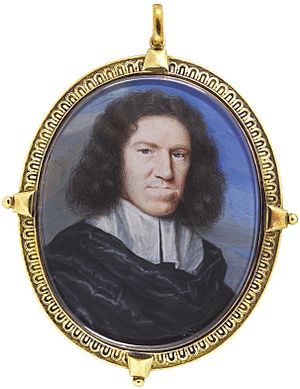George Wakeman facts for kids
Sir George Wakeman (died 1688) was an important English doctor. He was the personal physician to Catherine of Braganza, who was the wife of King Charles II of England. In 1678, Sir George was falsely accused of a serious crime. This happened during a time when many people believed in a made-up story called the Popish Plot.
A man named Titus Oates claimed that Sir George was part of a plan to kill the King. Oates said that Sir George was working with a group called the Jesuits. The goal, Oates claimed, was to put the King's brother, James, Duke of York, on the throne. However, Sir George Wakeman was found not guilty at his trial in 1679. This was a big moment because it showed that people were starting to doubt the truth of the Popish Plot.
Sir George Wakeman's Early Life and Loyalty
Sir George Wakeman was the son of Edward Wakeman. His mother was Mary Cotton. He grew up as a Roman Catholic. He studied medicine in other countries, possibly in Paris.
Like his older brother Richard, Sir George was very loyal to the King. He even fought for the King during difficult times. He was once put in prison for being part of a plan against Oliver Cromwell. Cromwell was a powerful leader before King Charles II returned to the throne.
Sir George's strong loyalty to the King was very important later on. It helped him when he was accused of treason in 1679. King Charles II remembered Wakeman's past service. This loyalty helped Sir George prove his innocence. Many people, like his friend John Evelyn, believed he was a good man. They found it hard to believe he would be involved in such a plot.
On February 13, 1661, King Charles II made George Wakeman a baronet. This was a special honor. Later, around 1670, he became the main doctor for Queen Catherine. He was known as a highly respected Catholic doctor in England.
The False Accusations of the Popish Plot
The Popish Plot was a made-up story created by Titus Oates and Israel Tonge. They claimed that Sir George Wakeman was offered a lot of money to poison King Charles II. They said he was supposed to do this by poisoning the King's drink.
Oates and Tonge claimed that Sir George first refused the offer. But they said he later agreed when he was offered even more money. They also claimed he attended a secret meeting and was promised a high position in the army.
When Sir George first appeared before the King and his advisors, he defended himself strongly. He reminded them of his long history of loyal service to the King. Because of his strong defense, the King's advisors did not immediately arrest him.
The Trial and Acquittal
Sir George Wakeman was officially charged with treason on July 18, 1679. His trial took place at the Old Bailey court. Three priests were also tried with him. The main judge was Lord Chief Justice William Scroggs.
The main people accusing Sir George were William Bedloe and Titus Oates. Oates claimed he had seen a paper that appointed Wakeman to a high army position. However, during the trial, it became clear that Oates could not even identify Sir George or his handwriting.
Sir George and the other accused men defended themselves very well. They were not allowed to have lawyers at that time for treason cases. Their witnesses were listened to more fairly than in earlier trials. For example, Ellen Rigby, a housekeeper, was heard with respect.
Judge Scroggs, who had previously believed in the Popish Plot, seemed to change his mind during this trial. He spoke strongly about how weak the evidence was against Wakeman. He told the jury that they should not assume everyone accused was guilty. After thinking, the jury found all the prisoners, including Sir George, not guilty.
This acquittal was a big blow to the Popish Plot's credibility. It made many people doubt the whole story. However, there was also some public anger. The jury members had to leave their homes because of angry crowds. Some people even threw a dead dog at Judge Scroggs.
After the trial, Sir George Wakeman went to Windsor Castle to see the King and Queen. He then left the country for a while. Titus Oates continued to spread his false stories, even after the verdict. Sir George returned to London by 1685. He gave evidence against Oates in Oates's own trial for lying under oath. We don't know much about Sir George Wakeman's life after that.


